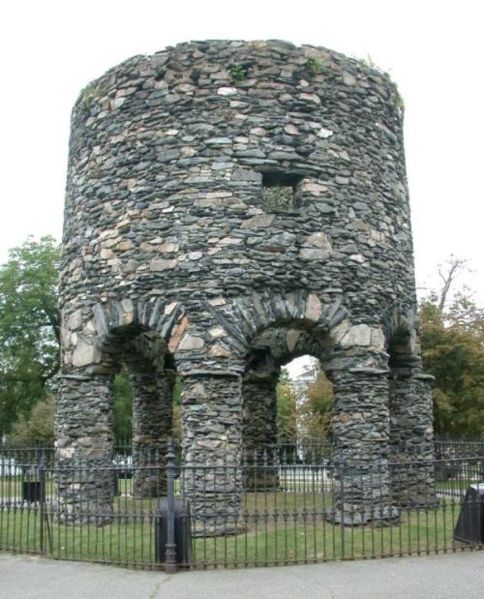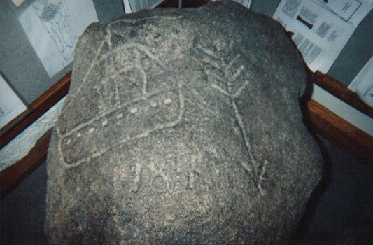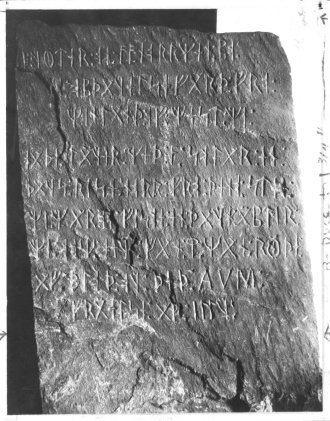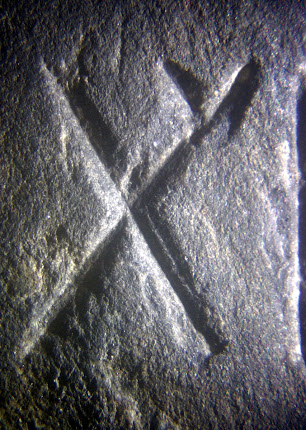Rebuttal to David
K. Schafer’s Westford Knight Report
For a number of years, a “report” or “survey’ has been
floating around the internet, purportedly written by a David K. Schafer,
Curatorial Assistant for Archaeology at Harvard's Peabody Museum of Archaeology
and Ethnology, in which Mr. Schafer questions the validity of the so-called
Westford Knight carving in Westford, Massachusetts. I wanted to take a few minutes to respond to
this report since, like many things on the internet, it seems to have taken on
a life of its own. A link to a summary
of the report can be found here: http://www.ramtops.co.uk/westford.html.
First, although the summary of Mr. Schafer’s report has been
cited dozens of times, I can find no evidence the actual report exists. If there is such a report, it has never been
published or even posted on the internet.
Although the summary, which first appeared in 1998, states that the
report “will be published in the Massachusetts Archaeological Society Bulletin
as well as some regional publications,” 16 years have now passed; I think it
safe to conclude that this was an erroneous statement. In addition, the summary states that this was
a “preliminary” report—presumably more research was needed before the report
could be finalized. (In fact, nowhere in
the summary does it confirm that Mr. Schafer even visited the site—he may have
been working from photographs.) Finally,
based on private correspondence I have seen, Mr. Schafer acknowledged in 2004
that his report was written in a “tongue in cheek” manner and was never
intended to be made public. In short, what
has been circulating on the internet is a summary of an unpublished
“preliminary” report posted by a third-party who claims to be an acquaintance
of Mr. Schafer, a report that Mr. Schafer apparently later distanced
himself from.
Second, many critics of the authenticity of the carving rely
on Mr. Schafer’s statement that “the flat bedrock [upon which the Knight is carved]
would have been buried under 1-3 feet of soil” during the 14th
century because the bedrock is located in what would have then been a hardwood
forest. What Mr. Schafer failed to note
is that the bedrock in question abuts an ancient Native American trail running
up Prospect Hill in Westford and cutting through any such forest—it is entirely
possible that frequent use of this trail would have exposed the bedrock and
prevented the soil buildup described by Mr. Schafer. Mr. Schafer was apparently unaware of this
trail, which changes the area topography and presumably would have changed his
analysis.
Third, Mr. Schafer concluded with “the simple fact that the
town historian has evidence that the ‘T’ was made by two local boys in the
late-19th [sic] century.”
This conclusion may be ‘simple’ but it is hardly a ‘fact.’ It is apparently true that two local boys added
to the carving in the late 1800s by inscribing a “peace pipe” to the area near what
many believe to be the face of the Knight.
But this “peace pipe” was carved
into the bedrock rather than pecked
into the bedrock as was the case with the rest of the carving. More to the point, Mr. Schafer failed to acknowledge
(probably because he was unaware) that the carving was written about in the
town history as a mystery of unknown origin in 1873—at a time when the oldest
of the local boys in question was only a toddler. See Elias Nason, Gazetteer of the State of Massachusetts (B.B. Russell, 1874), at
page 542. The dates simply don’t work
for Mr. Schafer’s conclusion. In fact, the 1873 reference and a later 1883 reference describe the carving as a mysterious historical oddity even then, and postulate the images were carved in the past "by some Indian artist." Ibid. Since the Native Americans were all forcibly removed from Westford and surrounding areas in the late 1670s, any such Native American work would presumably have to predate that decade.
Fourth, Mr. Schafer acknowledges that the sword area of the
carving (what he calls a “T”) is manmade using some kind of punching or pecking
technique. He does not, as some opponents
of the carving’s validity assert, claim that the entire carving is comprised only
of natural striations in the bedrock.
In conclusion, it is time that scholars, researchers and
members of the media stop relying on Mr. Schafer’s so-called report. The report is flawed, factually inaccurate,
incomplete and not intended for publication; it has no place in the ongoing and
important debate regarding the validity of this historic artifact. Much has been written about the Westford
Knight—those who continue to rely on Mr. Schafer’s report rather than seek out more
legitimate sources are being either intellectually lazy or intentionally biased.
In place of Mr. Schafer’s report, I offer an analysis of the
Westford Knight carving compiled by Joseph A. Sinnott, the former Massachusetts
State Geologist for twenty-two years who also served as the Director of the
Massachusetts Underwater Archeology Board:
“After a lengthy and
detailed study of the rock outcropping in the field it is my considered opinion
that a pecked and etched image of an historical event has been employed on the
bedrock. I can discern the outline of a sword,
a sailing vessel, etc. Natural or
glacial markings such as striations, grooves, polishing and weathering are all
apparent on the rock but do not diminish the stature of the image placed there
at a much later date.” [Letter dated October 14, 1999, addressed to Massachusetts Historical Committee.]
As Mr. Sinnott states, the carving on the bedrock displays
a historical event. It is up to modern
researchers and scholars to determine exactly what that event was. To do so requires the use of legitimate
source material.
David S. Brody
March 26, 2014





